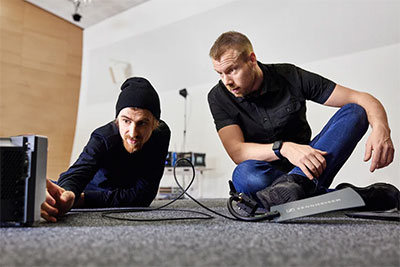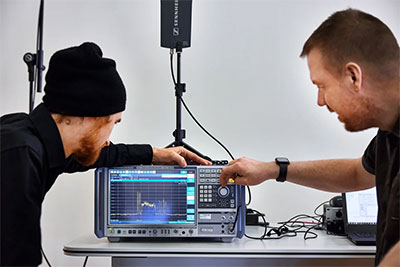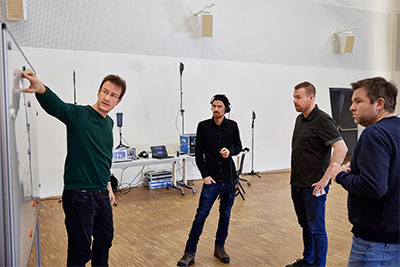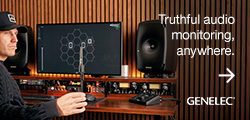![]() With wireless multichannel audio established as an essential element of large-scale music events, theatre productions and broadcasting, can Sennheiser’s WMAS (Wireless Multichannel Audio System) technology survive a practical test by two seasoned frequency managers?
With wireless multichannel audio established as an essential element of large-scale music events, theatre productions and broadcasting, can Sennheiser’s WMAS (Wireless Multichannel Audio System) technology survive a practical test by two seasoned frequency managers?
How does the system ‘get along’ with narrowband systems? And how does it respond to direct interference?
Freelance frequency coordinator Marco Völzke and Sennheiser Technical Application Engineer (and owner of a frequency coordination company) Jonas Naesby met with the Sennheiser WMAS inventors to put a prototype through its paces. ‘The aim was to stress-test the system to examine how it behaves under pressure, and to see what would happen if you did everything wrong,’ Naesby explains.
A WMAS system was set up in an 8MHz TV channel and had an analogue IEM system operating at high transmission power on the frequencies in the lower of two adjacent channels, and an eight-channel digital EW-DX wireless microphone system in the upper. Normally, the spectrum between IEMs and mics is not used but kept as a guard band, but the test placed WMAS in this ‘no-go’ channel to see if it could still operate without audio interruptions.
To stress the system yet further, in-band ‘interferers’ were introduced into the TV channel used by WMAS, simulating real-life incidents such as an ENG crew arriving at a show with non-coordinated equipment, or a user mistakenly switching on a narrowband mic on an old, preset frequency.
 Jonas Naesby (JN): ‘Productions are not slowing down but growing, whether that’s conferences or music festivals. More and more acts bring more and more wireless. At the same time, we have a decline in available frequency resources. That’s why we see a growing demand for frequency coordination – it’s simply impossible to run an event without strict control of who uses what when.’
Jonas Naesby (JN): ‘Productions are not slowing down but growing, whether that’s conferences or music festivals. More and more acts bring more and more wireless. At the same time, we have a decline in available frequency resources. That’s why we see a growing demand for frequency coordination – it’s simply impossible to run an event without strict control of who uses what when.’
Marco Völzke (MV): I totally agree. The expectations of both organisers and audience have increased massively – they want big entertainment, something they have never seen before, something unforgettable. I’m not only talking about big concerts as, today, even a normal congress starts with a huge opening ceremony. A lot is done to impress people, to show excellence.
‘If you take a look at a typical medical congress, you will find a big show, and it’s totally normal that this congress has its own TV channel, which is broadcasting for the entire event.
‘Then we have other devices that occupy our spectrum. Some wanted – like controls for moving lights or special effects – and then unwanted interference of say, a video switcher or the like, as all these devices are packed closer and closer together. You now have 360° LED walls with just a tiny opening for a person to get in and enjoy an immersive A/V experience. All these elements taken together cause interference problems that can no longer be controlled. A few LED walls may not be problematic but if you arrive at 200, the interference will add up. When event organisers come up with an idea that has never been implemented before – that’s when issues are likely. Creativity knows no limits, and each time I solve a challenge the next one is just around the corner.’
JN: ‘And while we see a new generation of LED screens that are way less problematic, there is a whole new series of products being pushed into production that are now radiating RF and causing interference, be it lighting, video, control or whatever.’
MV: ‘The physics of interference don’t end with special effects. At one show, we realised that interference problems were coming from our RF IDs. In some countries they are allowed to transmit at more than 30W! Also, the need for wireless at events is increasing due to the on-site and the hybrid part, the streaming that happens simultaneously. It’s not the world before Covid or during Covid, you now have to satisfy both worlds.’
The test stressed the WMAS prototype to see it how it would perform when used alongside narrowband systems. What were the findings?
MV: ‘I was blown away by the performance. I’ve never heard such audio quality coming from a wireless in-ear monitoring system, with precise positioning and almost palpable stereo depth. The RF side is my profession, but I was first blown away by this natural sound; it’s like I’m sitting at my desk with headphones on but here I can walk around. And this again gives people with a creative mind a new level of freedom. I’m really excited to see what the creative industry will do with these systems – maybe immersive audio projects. I think this is the first system that you can try out for this and impress artists and listeners. This might be a new type of event that has not been possible before.
‘On the performance and the co-existence test, we compared broadband and narrowband under very severe conditions, pushing the limits, comparing their behaviours. Our first finding is that digital is the only way to go, because analogue gives us far too many problems that we can’t control. With WMAS, the flexibility, range, and robustness were very impressive.
‘I was also quite impressed with how well the system deals with interference. We tried limits we just do in tests. For example, you would never go up on stage, walk up to the singer and put another transmitter just next to their radio mic. We did this with WMAS and it handled it. This goes to showhow well thought out this whole technique is – also the capability to handle this much interference and to deal with fading.
‘We also tested under normal conditions, just to check how the system and its single antenna are working – how the frequency reacts, what the range is, spectrum occupation, etc. All parameters were better than expected and I think this technology will give us new possibilities going forward. Rethinking the frequency and time domains, learning from existing systems and thinking in new ways about the underlying physics will also improve how we do our RF management in the future.
‘Innovative aspects are the bidirectional transmission, simultaneous control of transmitters and receivers, and the fact that we just need to put one piece of equipment on an artist. This will give them more freedom.
 ‘When I put two devices on someone today, I have to deal with some physical problems – in future, the system itself will take care of this. I won’t have to worry about frequency ranges, transmission power, occupation, audio quality, I will just set it up in the system and the system would arrange these parameters, and could handle some interference from the outside, too.
‘When I put two devices on someone today, I have to deal with some physical problems – in future, the system itself will take care of this. I won’t have to worry about frequency ranges, transmission power, occupation, audio quality, I will just set it up in the system and the system would arrange these parameters, and could handle some interference from the outside, too.
JN: ‘Today’s test was very successful and very, very impressive. Setting up any wireless system, we often get asked what the range of the system is, and I always reply, “how long is a rubber band?”, because it always depends on how much effort you put into building your link. It’s a matter of transmission power, positioning of the belt pack, the antenna system, background noise – all these parameters influence how a system is working. In general, we always design a system to work in a certain area, and that involves various different techniques in terms of component selection, frequency selection, location and so on. There are various different best practices like Marco just mentioned; frequency spacing, or physical spacing if you have two belt packs on the same artist. And this system does all of that more or less by itself.
‘In the test, we were stressing the prototype far beyond any proper reasoning; we did not follow any best practices. Usually, you can do a number of things wrong and still get through a show on a standard stage. Today we did everything wrong to some extent and this system just kept performing. We had direct interferers right on its channel, we had interferers next to it, and physical spacing that’s absolutely not intended with any system whether narrowband to narrowband or narrowband to broadband.’
MV: ‘…even with touching antennas.’
JN: ‘All the stuff we preach you should never do, we did it and we got way better results than I was expecting. Also, the technology has the capability of easily adding range extension if that should be needed. If you wanted to go further or if we were to add even more interference, we could have solved that, too, as we were only using the standard package for the test.’
MV: ‘And it would be an easy extension with standard components. No thinking which antenna combiner/splitter we need, which special cable I have to use, how to control the RF power on both sides, transmitting and receiving.’
JN: ‘While it is quite easy to extend the range of a narrowband microphone system, it’s way more complex to extend the range of an IEM system because the amplifiers needed to do that are not off the shelf, they are costly, it requires filtering and they are so easy to overload. With WMAS technology, extension is “built-in” because of the possibility to use multiple antennas for range extension.’
What were your initial thoughts about WMAS regarding frequency coordination?
JN: ‘This was also part of what we tested today. We put up a number of narrowband systems, mics and IEMs, digital and analogue, and we deliberately placed the WMAS prototype on a chunk of spectrum we would normally not use at a gig because it was sitting right next to an IEM channel. At most, these would be the last-resort frequencies that we would hand out, maybe to an ENG crew at the other side of a festival site, something like that.’
MV: ‘That is a typical frequency security guard between IEM systems and microphones. So we had a lot on one side, a lot on the other, and even some interfering transmitters directly on the WMAS frequencies – and the prototype behaved way better than we thought.’
 When coordinating a mixed set-up of narrowband mics and IEMs, and a broadband WMAS system, is there anything that you need to take particular care with?
When coordinating a mixed set-up of narrowband mics and IEMs, and a broadband WMAS system, is there anything that you need to take particular care with?
JN: ‘No, it actually opens up possibilities that we don’t have today. We can use more of the spectrum more efficiently. I personally still do a block coordination anyway sometimes, so I will have a certain narrowband frequency coordination within a TV channel. I do block intermod calculations of blocks that are individually intermodulation-calculated as well, so I can easily move systems around. With WMAS, I don’t even have to include this in my overall block intermod calculation, and just put the systems in blocks I wouldn’t normally use on that stage for anything. I would maybe use these blocks on another stage, but I would never use them on the same stage, and today proved: That can be done.’
MV: ‘That’s a new freedom we got – the possibility to reuse our spectrum more often and in a better way. Like using these security guard bands between things that have to stay apart – making use of all the space we’ve got.’
Are these guard bands always the size of a TV channel?
MV: ‘It depends on how heavily I’m using the narrowband signals in a TV channel and which systems I’m using. For example, if I’m using a very old one, maybe six radio mics and then the same amount of in-ears, I would prefer more than one TV channel. Sometimes up to 16MHz because the front-end filter can be very wide, so the system is sometimes not able to block interference within this range. So I try to keep them apart frequency-wise as much as possible. 16MHz would be a normal size, sometimes even three TV channels. With WMAS, it’s possible to place systems directly next to each other. If I selected a guard band of less than 8MHz it would be difficult because you have – until now – analogue transmission as there are almost no digital in-ear systems on the market. You cannot place analogue IEMs with an equidistant spacing, and you have to calculate the intermods – mixed set-ups would always create problems.
‘With WMAS it will be much easier as everything is digital, also the in-ears: I can place all units next to each other if I’m really in need of space. And that’s why I wanted to do this test.’
Do you think you will always find a free space of 6MHz or 8MHz for WMAS? Or have you already encountered situations where a free TV channel wasn’t available?
JN: ‘There are a few places on earth where there is almost no empty TV channel but in most places this is not going to be a problem. If you are going to a place where spectrum is so limited, you are always taking special measures to get your narrowband systems working anyway. And if, for example, there is just one empty TV channel, the best system to bring in future will be WMAS, because we can populate this channel way better with both in-ear and microphone systems in the same gap. So basically, it would be the solution for those locations where frequency space is extremely scarce.’
MV: ‘If TV-UHF was full, I would go straight to a 1.4GHz WMAS system; that would make it much simpler for me.’
Any additional thoughts on the combined IEM/mic belt pack?
JN: ‘The single belt pack is going to open up so many opportunities. You often have a limited number of devices, whether belt pack receivers or transmitters, and you work your way around that. With the new technology we have the possibility of always adding a microphone input for an IEM or vice-versa. Rental houses will have complete flexibility and only need to stock one belt pack instead of a transmitting pack and a receiving pack and those in different UHF frequency ranges – here it basically comes down to two devices in two different frequency ranges, TV-UHF and 1.4GHz.’
MV: ‘Consider the logistics behind this: just one battery and one space for one type of belt pack, and not one big table for mic belt packs and another big table for in-ears – just one device, one space, one name, one label. It’s going to make life easier, not just for the frequency coordinator, but for everyone.’
JN: ‘Also, real estate and truck space are a concern for many. Maybe not for the biggest tours, but for many of the smaller acts and flying tours.’
MV: ‘It’s possible to take a 64-channel system in a tool case with you on a flight. The 1U unit at the bottom, the belt packs on top, one antenna, maybe a second one and you’re ready to go. This is not possible today.’
JN: ‘Comparing it with conventional radio and the amount of wiring at the back of a rack, and the potential of that specific receiver missing out on RF on one side because there is a poor coax cable and all of that – it’s gone. All that triple checking, is everything patched correctly, is every synced receiver receiving the correct levels through the whole distribution network, all of that – no need any more.’
Do you have any concluding thoughts?
JN: ‘We wanted to test the limits of the technology, and the worst scenario would be if an interfering in-band carrier, or two or four as we had today, killed all your 64 channels. That’s probably the biggest worry for everyone adopting this technology; it’s like all or nothing. And we clearly saw: That’s not the case. We created an absolute worst case with four interfering transmitters, and while the WMAS belt pack that was closest to these interfering devices broke down, the rest of the system was still operating perfectly.’
MV: ‘Just the belt pack which was very stressed. After about 80m, I started to get drop-outs as the belt pack was just a few centimetres from an interfering transmitter, but I was still able to communicate. When the interfering device was put at a distance of 250mm, the range increased to more than 100m.’
JN: ‘One of the benefits that WMAS definitely has is that we are scanning into the background noise of the actual carriers we are using. That has never been possible before.’
MV: ‘Yeah, with all our fancy spectrum analysers we can basically only measure all the frequencies we are not using. Because if someone sits on top of one of our frequencies, we cannot see it. That’s a fact.’
JN: ‘But with WMAS we can. So not only does it work better with bad interference and is resilient to that, it’s also much better at detecting it and helping us locate the source.’
WMAS passed the co-existence check with flying colours. It worked perfectly when sandwiched in between a narrowband analogue IEM system and a narrowband digital wireless microphone system, and did not affect these systems either. Its lower spectral density and power of a single narrowband microphone are key for this friendly co-existence. Furthermore, the fact that WMAS was positioned in what is usually a security or guard band shows that it can contribute to higher spectrum efficiency, allowing much denser deployments at multi-stage festivals and installations in general.
When faced with multiple in-band interferers, simulating third-party, unapproved frequency use, the system still performed extremely well where narrowband systems would have failed if interference happened on their frequency. The WMAS prototype reliably indicated the presence of these narrowband interferers and suppressed them.
Only when a fourth interferer was added directly onto the WMAS channel, with all four in-band interferers positioned very close to each other, a single WMAS belt pack failed, the remainder of the system was stable. In cases like these, WMAS’s ability to detect in-band interference helps the frequency coordinator to quickly locate and eliminate the source of interference.












